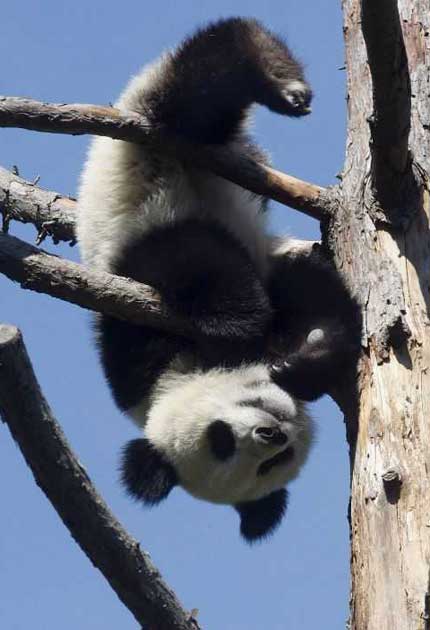Hands off the pandas
Broadcaster Chris Packham has set fur flying with a claim that the endangered bears should now be left to die out. Simon Usborne leaps to their defence

Poor Yang Yang and Kou Kou and Lun Lun. Chris Packham thinks you and all your panda friends are good-for-nothing, bamboo-munching, taxidermist-dodging benefit cheats. In an interview with Radio Times, published yesterday, the BBC nature presenter launches a viscous assault on the embattled species. He says the giant panda has "gone down an evolutionary cul-de-sac". He adds: "It's not a strong species ... I reckon we should pull the plug. Let them go with a degree of dignity."
And it gets worse. Last year the birdwatcher even threatened to "eat the last panda if I could have the money we've spent on panda conservation to [spend on] more sensible things". Eat a panda? What are you saying, Chris? Why not polish off a blue whale? You've got the mouth for it.
Packham is right in one regard – the panda is under threat and often seems hopeless. Habitat loss, poaching and the bear's notorious disinterest in making baby pandas has left it clinging to life in isolated mountain ranges. There are fewer than 2,000 pandas in the wild, around 250 in captivity.
But since when was it OK to "pull the plug" on one of the world's most recognisable and best loved animals? Predictably Packham's comments have caused uproar among panda lovers and animal experts (and presumably, Chinese people). So Chris – eat this. We present five reasons why the panda is worth saving...
Pandas are symbols of conservationism
Giant pandas belong to a select breed of animals qualifying as "charismatic megafauna". They are the poster boys of the natural world – the "T-shirt" animals whose plight is elevated to get us moist-eyed and agitated. "But pandas didn't ask to be cute and cuddly," says Mark Wright, the science adviser at WWF (which has a panda for a logo). "The point is that by saving the panda you are saving the dozens of other endangered species that are unique to those habitats." So if we did pull the plug on the panda and its habitat, Wright says, we'd also kiss goodbye to the Sichuan wood owl and the Snowy-cheeked laughing thrush. And they're birds, Chris – you like birds.
They are Chinese cultural icons
There is no animal the Chinese love more, besides the mythical dragon, than the giant panda. They're called "di xiong mao", which means "big bear cat" and serve as a symbol of national pride. The animal appears on commemorative coins and Jing Jing the panda was one of Beijing's mascots, elected by Chinese voters, at last year's Olympics. The panda is seen as a manifestation of the Yin and Yang philosophy of Chinese society. Their black and white coats and placid nature are held up as examples of harmony. And they have practical value. "Panda diplomacy" has helped Beijing build bridges, most recently with Taiwan, usually by loaning animals to zoos.
They are unique
There are two kinds of animals of interest to scientists – common ones (think flies) and the rare ones that may hold valuable secrets. "Pandas are famous in evolutionary science because they developed out of their wrist a unique appendage that works as a specialist thumb for stripping bamboo," says Bill Sutherland, a professor of conservation biology at Cambridge University. All too often lessons from nature die with endangered species. The gastric-brooding frog incubated its eggs in its stomach. Scientists seeking a cure for gastric ulcers were studying the acid-proof substance that protected those eggs until the frog became extinct. "You never know why or when a species will become vital to science," says Sutherland.
They're good for humans, too
The panda's future isn't only important for the species who share its home. Pandas have become rare largely thanks to human encroachment. Vast tracts of south-east China have been deforested or given over to agriculture as China tries to fuel and feed a rapidly-growing population. Pandas are now one of the most protected species on the planet. The Wolong National Nature Reserve in Sichuan Province is one example. It is home to 150 pandas – and thousands of people. "Most of them derive a living from the panda," says Iain Valentine of Edinburgh Zoo. "They depend on pandas thriving."
They're really cute
Packham may say it's the panda's doe-eyed tranquillity and teddy-bear features that have skewed our perspective – but there's no denying the bear's cuteness. It turns out there's science behind our soppiness. The Austrian zoologist, Konrad Lorenz, argued that humans react positively to animals that resemble babies, because we have evolved instinctively to care for our offspring. So humans are genetically disposed to animals with big eyes and heads and cute little ears. If evidence of this theory were needed, visit YouTube and search for "sneezing baby panda". The clip, which has been seen 40 million times, shows a mother jumping out of her fur when her offspring interrupts teatime with an almighty sneeze. Packham either hasn't seen it or doesn't have a heart.
Subscribe to Independent Premium to bookmark this article
Want to bookmark your favourite articles and stories to read or reference later? Start your Independent Premium subscription today.

Join our commenting forum
Join thought-provoking conversations, follow other Independent readers and see their replies